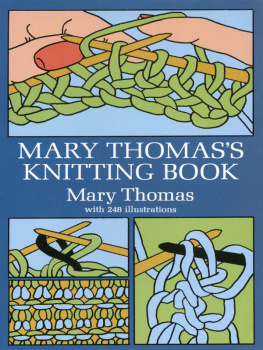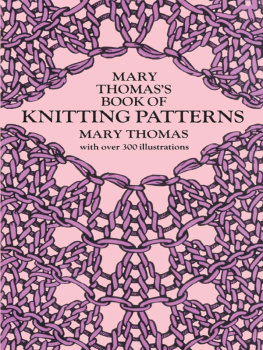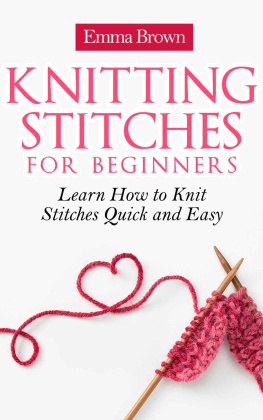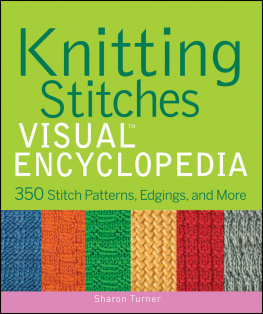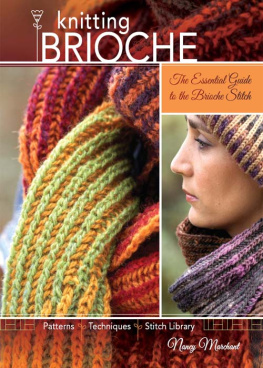
The Visit of the Angels, by the Master Bertram (date about 1390)
The Knitting Madonna
(see page 6)
[Frontispiece]

This Dover edition, first published in 1972, is an unabridged republication of the work originally published in 1988 by Hodder and Stoughton, Ltd., London. It is reprinted by special arrangement with Hodder and Stoughton, Ltd., Warwick Lane, London, E.C.4.
Library of Congress Catalog Card Number: 72-188814
International Standard Book Number
ISBN-13: 978-0-486-22817-4
ISBN-10: 0-486-22817-7
Manufactured in the United States by Courier Corporation
22817721
www.doverpublications.com
DEDICATION
This book is dedicated with
gratitude and affection
To my Uncle
MR . J. W . LOVEGROVE
for all his many kindnesses, help
and encouragement
CONTENTS
I F ALL THE LOOMS in the world ceased to produce cloth, and the art of spinning and knitting alone remained, we could still be clothed, both warmly and fashionably.
Such is knitting, which without doubt is the most resourceful and inventive method of fabric construction in the world, being made without loom or machine, without warp or weft, shaped as it is constructed, patterned as whim requires, and divided without being cut!
All things are possible in knitting. Women knit almost by instinct, men now for pleasure, though not so long past it provided him with a means of livelihood.
To understand something of the vast and resourceful scope of the art it appears necessary to know something of its past history, when knitting meant so much to the world in general. Such has been attempted in this book. The different methods of knitting practised by other nations, familiar and unfamiliar, have been collected, sorted and assembled into position. These will provide a wealth of ideas for either novice or adept.
All the diagrams have been made with care, and selected so that less familiar forms of knitting can be followed and learned with accuracy.
Detail to some length has been devoted to the subject of knitting implements and yarns, the making of which was at one time an integral part of a knitters education. Needles and yarn are the implements of the knitter, and all implements are better used and appreciated when they are understood. This knowledge also ensures a more reasonable comprehension of that mysterious thingtension!
In teaching a child to knit, begin right. Let her learn how to hold her needles, wind her yarn, cast-on and cast-off in tension. Pair her stitches when forming an increase or decrease. Turn. Create different triangular shapes, learning their use. Knit-up, and so forth. These are the technique of knitting, upon which the whole structure is built; and, learnt young, will never be forgotten.
Knitting should be done thoughtfully. It should not be hurried. That is its charm to our generation, who live surrounded with a wild helter-skelter of speed. It is creative, and that is its supreme satisfaction. If things go wrong, dont get impatient. Remember, it took six years to make a master knitter!
All ages have contributed their quota to the progress of knitting, and that contributed by the modern knitter is style. A modern knitted garment is not a thing to be dragged on for extra warmth, but has, in its own right, a place in the world of fashion.
This new desire for style, as now in evidence, demands new methods of treatment, and the suggestion that all knitters should construct a basic pattern to their own measurements, and so make their garments to a definite known size, appears more reasonable. This, at least, will ensure fit, and fit IS style. Design is another thing and decided upon beforehand, and for knitted garments should be simple, as variety is obtained by change of fabric, which lies literally at the finger tips.
For this purpose of simplicity the pattern suggested here is that of the body-line, as this can be used for all purposes, whether the garment is being originated by the knitter herself, or constructed from written directions.
Style also demands precision of details, shaping, etc., and these in turn demand a precise knowledge and methods of increasing and decreasing and of refining the fabric by change of needles. These subjects have therefore been treated in great detail so that the best results can be obtained, while the different methods of casting-on as detailed will yield a never-ending source of dainty edges.
At first I had hoped to present the whole story of knitting in one volume only, but this eventually proved impossible, as the subject was too vast. So, with the greatest reluctance, a division had to be made, leaving the fascinating art of fabric construction, which rose to such heights of beauty in the brocade and lace periods of knitting, and which is now rapidly being multiplied, for a later book. This is already in preparation.
These two books will, I hope, give a wider interest to this great and fascinating work.
This mark (the well-known danger signal to travellers) is used throughout this book to indicate points of vital importance where beginners are likely to falter. It should be heeded, and so save a lot of trouble. Its there to say Look out.
MARY THOMAS
I N PRESENTING this first book on the subject of knitting, I would like to acknowledge with my sincere thanks and gratitude the brilliant and painstaking work of the artists Miss Margaret Agutter, Miss H. Lyon-Wood, Miss Dorothy Dunmore, and Miss Mary Kirby. The delightful little caricatures which flavour the text with atmosphere and humour are the work of Miss Margaret Agutter.
My thanks are also due to the many people of different countries, Europe, Asia and America, not forgetting the Shetland Isles, who have forwarded me much valuable information; also to Dr. Fritz Ikley, Dr. Hans Haug, Mrs. Gertrude Mason, for their kindly help, and Miss Dorothy Moss for typing the MS.
The great kindness of various people and museums who have loaned articles for illustrations is acknowledged with thanks beneath the pictures respectively reproduced.
MARY THOMAS

WHENEVER YOU SEE THIS SIGN 
STOP!
CAUTION !!
GO !!!

Fig. 1. A Knitted Masterpiece. Initials P. I. E. Dated 1713
K NITTING, like .
Egypt learned her knitting from the Arabs, and it is only in Coptic Egypt, and where Arabian influence could penetrate, that Egyptian knitting discoveries dating from the 4th and 5th centuries have been found (see ). At what date knitting actually originated no one knows, but in the ancient city of Yemen, in Arabia Felix, earlier known as Shabwa, the city of the Queen of Sheba, it is said to have been known for ever, and that the pattern on the serpents back was knitted by Eve. Such is Eastern chronology.
Historians place the date about A . D . 200, but legend claims that the seamless garment of Christ was knitted and so could not be cut or divided; and lots were cast for it.
Legend again provokes a claim to Penelopes web which she wrought by day and unravelled so quickly by night, saying it was knitted! Was this Frame knitting?
Next page
